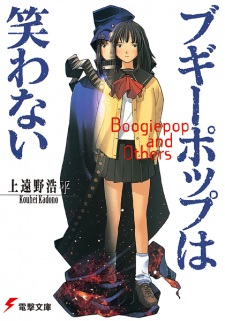“I am automatic. When I detect adversity approaching, I float to the surface. That’s why I am Boogiepop—phantasmal, like bubbles.”
First of all, this review only includes the first three light novels in the Boogiepop franchise, as they are the only significant ones that have been licensed by Seven Seas Entertainment. This includes Boogiepop and Others, Boogiepop Returns: VS Imaginator, and Boogiepop Returns: VS Imaginator Part 2. I also own the brilliant Boogiepop Phantom anime, but that is for another review.
Kouhei Kadono’s Boogiepop light novels, stories that I would describe as the morbid side of young adult fiction, are recognized as the success that sparked the
...
Alternative TitlesJapanese: ブギーポップシリーズ InformationType: Light Novel
Volumes: Unknown
Chapters: Unknown
Status: Publishing
Published: Feb 10, 1998 to ?
Theme:
Psychological
Serialization:
None Statistics Ranked: #4062 2 based on the top manga page. Please note that 'R18+' titles are excluded. Popularity: #1752
Members: 12,790
Favorites: 365 Available AtResources | Reviews
Filtered Results: 5 / 5
Sort
Your Feelings Categories Aug 9, 2019
the first volume in the boogiepop series is probably one of that best books ive read in awhile. all the characters are well fleshed out, you could realistically put them into tropes but it would be a great disservice to them. the tone of that book of overall is dark, most of the story takes place at a secluded school in the mountains and that adds to it. along with the musical references to 80s bands like oingo boingo, prince and the npg. it gives off this tone that's very, boogiepop". In the authors note kouhei kodono speaks about what boogiepop means, combining niche topics,
...
Mar 27, 2023
I think this sort of fantasy story works because Boogiepop itself links back in some way to reality. The idea of Boogiepop is pretty similar to the human body’s autoimmune system and how it fights off diseases. Your mind can easily accept Boogiepop’s existence since it already has a prior reference point to work off of.
The individual narratives in Others are good but the plot itself isn’t great. The Manticore feels like a derivative idea. The fight between the Manticore and Boogiepop’s allies is exciting enough, and I like the bit of foreshadowing with the boy who’s good at archery, but its not as engaging ... Nov 17, 2019
“There is an urban legend that children tell one another about a shinigami that can release people from the pain they may be suffering. This "Angel of Death" has a name--Boogiepop. And the legends are true. Boogiepop is real.”
Boogiepop is a light novel series written by Kouhei Kadona and drawn by Ogata Kouji. The premise revolves around the character Boogiepop. A Shinigami that takes over the body of Miyashita Touka and tends to deal with certain characters and creatures that post danger to the world. Most of the review will focus on the first story ‘Boogiepop and Others’ as that is probably the most well ... Feb 11, 2023
"...The actual events probably form a very simple story. From a distance, they appear to be quite confusing; to have no clear threads connecting them whatsoever, but the reality is that this is undoubtedly a much more straightforward, commonplace tale." - Boogiepop and Others
Thus opens the first volume of Boogiepop, and this statement perfectly describes the main theme of Boogiepop - the importance and relevance of all perspectives both in stories and, ultimately, the world at large. Without getting into details, the first volume conveys this idea by presenting different parts of the same story from five different perspectives, which all come together to form ... |

